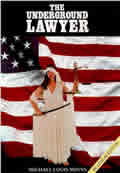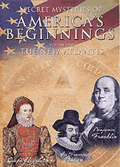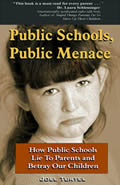COWARD NO MORE, HOMAGE TO HOLDER
by
Alan Stang
February 27, 2009
NewsWithViews.com
[Announcement: Did you know Alan Stang has a new radio show? Click here for details.]
In his first major speech, pretend Attorney General Eric Holder called Americans cowards for not talking about race enough. Eric the Red is of course not really Attorney General, because the Communist enemy alien who appointed him is not really President (hence “pretend”). Also, he called us cowards in celebration of “Black History Month,” a pretend event (there was no black history, because there was no language to write it). “Black history” did not begin until it intersected “white history.”
Despite all that, I herewith defer to his admonition and strive to regain my manhood with this discussion of race; N.B., pretend Attorney General Holder. Don Jordan and Michael Walsh are the English authors of White Cargo: The Forgotten History of Britain’s White Slaves in America (New York, New York University Press, 2008). This book will drive a final stake through the heart of the race racket.
In Communist government school, they told us about “indentured servants” in early America who agreed to work seven years to pay for the expense of bringing them here. As you will remember, that was all they said; they dropped the perfunctory subject and went on to the truly horrifying study of black slaves from Africa.
The purpose of this piece is not at all to minimize their sufferings. It is, rather, to put those sufferings in context. Jewish swindlers who run what Professor Norman Finkelstein calls the “Holocaust Racket” have perpetuated bad feeling by insinuating that the only people Hitler killed were Jews. In like fashion, race racketeers, foremost among them Jesse “Shakedown” Jackson, the master of alliteration that could conflagrate the nation, insinuate that the only people ever enslaved were blacks.
The antidote to this is to browse through White Cargo. There, you will learn that those white “indentured servants” were in fact slaves just as much as the blacks, enslaved in conditions just as bad, often worse, and that white slaves were imported into this country almost as long as blacks. Indeed, did you know that the first slaves imported into the American colonies were 100 white children unaccompanied by parents – children? – yes, children. They arrived during Easter, 1619, four months before the arrival of a much more infamous shipment of black slaves. (P. 76)
Another 100 followed, then another and another, etc. Most of them died still children. It is perfectly true that the Dutch and Portuguese were shipping thousands of slaves to the New World from Africa at this time, but there was no market for them in Virginia. Six years later, in 1625, there were still only 23 Africans in the colony. Many decades later, there still only a few hundred. Most slaves in Virginia were white. (P. 87)
But was there not a basic difference in that white slaves were committed for seven years while blacks were enslaved for life? Not in practical effect, because many, maybe most white slaves died before they had served seven years. For running away, even for lesser infractions, they were not just savagely whipped; also, their sentences were extended for years, which often worked out to life. Sick and dying white slaves were kicked out, abandoned. Most of those who survived to be “freed” had nothing more than they had started their slavery with, including no money, no food, no shelter, etc.
The “difference” can forever be put to rest when you understand that “indentured servants” were considered chattels, property. Their owners bequeathed them in their wills. Here is the will of Abraham Coombs, of Maryland, dated December 26th, 1684: “I give and bequeath to my dear and loving wife all my servants, being two boys and one woman servant together with all my stock of hogs.” In 1655, the Angel, bound for Virginia, was hit by a storm. The statement of loss reported: “Amongst the goods saved were three servants valued at £30 who were disposed of in Barbados.” (P. 109)
Who were these white slaves? Some were “free-willers,” beguiled to the colonies by inflated promises that deflated aboard ship. Many were street people of one sort or another, loafers, vagabonds, child prostitutes, etc. Many were criminals, petty and otherwise, in jail and out. Their English betters feared and detested them. Transportation to the colonies was a good way to get rid of them. As early as 1618, people began to disappear, especially around English ports. Women were arrested with illegal warrants and shipped to Virginia. White slave traffic became a lucrative business. Slavers eventually scoured England for victims. Kidnapping became a national scourge.
Sometimes, the slavers literally tore children from the arms of their parents. White Cargo tells us: “. . . No child from either the town or the surrounding countryside seems to have been safe from the merchants’ agents. They operated openly and with impunity. When parents who had lost their children came looking for them in the town, their elation at finding them still incarcerated awaiting embarkation was short lived on their discovery that they were powerless to bring their children home. . . .” (Pp. 237-38)
Why? The kidnappers were paying off the local judges. Most parents could not afford to pay for the food their kiddos had consumed while prisoners. That’s right! The parents had to pay for that. They had to watch in impotent horror as their children were marched aboard slave ships and sent away to the colonies forever. Unbelievable? Yes.
All Americans are experts on the inhuman conditions endured by Africans in the holds of slave ships on the long voyage to the New World. What were conditions like on the slave ships that brought white slaves from England? Here is the testimony of George Selwyn, Member of Parliament, who visited a slave ship preparing to sail from England to Maryland in 1767:
“I went on board and all the horror I had an idea of is short of what I saw this poor man in chained to a board in a hole not above 16 feet long, more than fifty with him, a collar and padlock about his neck and chained to five of the most dreadful creatures I ever looked on.” (Pp. 250-51)
Another description of a white slave crossing says this: “There is on board these ships terrible misery, stench, fumes, horror, vomiting, many kinds of sea-sickness, fever, dysentery, headache, heat, constipation, boils, scurvy, cancer, mouth rot, and the like, all of which comes from old and sharply salted food and meat, also from very bad and foul water, so that many die miserably . . . . Children from 1 to 7 years rarely survive the voyage.” (Pp. 222-23)
When black slaves arrived in the colonies, they were sold at auction. What happened to white slaves? Exactly the same thing: “. . . Posters and, later in the Chesapeake’s history, newspapers announced the arrival of the latest cargo of servants. Potential buyers could read of the ages, gender and skills of those arriving and of when to clamber on board to inspect the human goods for themselves.” (P. 119)
All Americans are familiar with the horrors of the slave auctions of blacks in New Orleans. Here is a contemporaneous (1758) description by a London weaver who observed a sale of white slaves in Williamsburg: “They all was set in row, near 100 men and women and the planter come down the country to buy . . . I never see such parcels of poor wretches in my life some almost naked and what had clothes was as black as chimney sweeps, and almost starved by the ill-usage of their passage by the captain, for they are used no better than many negro slaves and sold in the same manner as horses or cows in our market or fair.” (P. 253)
Killing a black slave was not a crime in Virginia. Blacks were considered less than human. Many of the white slaves were brought here from Ireland, where the law said it was “no more sin to kill an Irishman than a dog or any other brute.” (P. 141) Indeed, disbelieve it if you will, but because the Irish reputation for rebellion was so bad, it was illegal in the 1650s to import an Irishman into Massachusetts. (P. 150) White slavery endured for more than 150 years. Until the Eighteenth Century, there were more white slaves than black, many more, in the Chesapeake.
We are building toward a devastating point that should finally kill the race racket. The point is that black slaves suffered no more than did whites; the point is that race ultimately made no difference. In a famous case, Anthony Johnson, an African, became a successful planter himself; he bought and sold slaves, black and white. Johnson was not the only black slaver. One of his slaves, a fellow black, demanded his freedom; Johnson persuaded a court to enslave him for life, thereby helping to install lifetime black slavery in America, a change that was not complete for many decades. (Pp. 169-71)
And did you know that in Barbados Irish slaves were so rebellious that “African slaves were recruited into the very militia that had the task of putting down slave rebellions. Africans carried arms to police both other Africans and their European colleagues in servitude.” (P. 192)
Lerone Bennett, Jr., is a black American historian. Bennett writes: “Not only in Virginia but also in New England and New York, the first Blacks were integrated into a forced labor system that had little or nothing to do with skin color. That came later. But in the interim, a fateful 40-year period of primary importance in the history of America, Black men and women worked side by side with the first generation of Whites, cultivating tobacco, clearing the land, and building roads and houses.” (P. 170)
Another black historian, Professor Audrey Smedley, says this: “Early references to blacks reveal little clear evidence of general or widespread social antipathy on account of their colour.” She says, “Records show a fairly high incidence of co-operation among black and white servants and unified resistance to harsh masters.” Historian Edmund S. Morgan says “the two despised groups initially saw each other as sharing the same predicament.” (Pp. 170-71)
Indeed, “there are indications from various sources that whites were in some cases treated worse than blacks. It was William Eddis, England’s Customs Surveyor in Annapolis, who reckoned that African slaves were better treated than Europeans on the plantations because they were more valuable, a lifelong property, whereas European servants mostly had a term to their service. Planters exercised ‘an inflexible severity’ over white servants, he said. ‘Generally speaking, they groan beneath a worse than Egyptian bondage.’ . . .” (Pp. 256-57) Black slaves were “limbed” or castrated. Whites were not, but half of them were dead in seven years. (Emphasis added)
What happened? Why did the cohesion between black and white slaves end? In 1676, there was a huge slave rebellion in Virginia. Black and white slaves burned Jamestown to the ground. Hundreds died. Later, the planters feared rightly that it could happen again. Our authors tell us their solution was to divide the races against each other, thereby creating a buffer between them and the blacks.
They instilled a sense of superiority in the Europeans and degraded the non-whites. Laws deprived them of rights in property, voting, family and in court. Their masters were even forbidden to free them. Whites were given new rights; their masters could not whip them naked without a court order. Hey, is this a great colony, or what?
“. . . And the notion of a ‘white race’ was promoted. Hitherto, the English had never applied colour to distinguish race. Now white servants whose daily condition was little different from that of Africans, were taught that they belonged to a superior people.” The races were given different clothing. Living quarters were segregated for the first time. But the whites were still slaves. White slavery continued, even multiplied into the next century. (P. 212)
Were you told any of this in school? Were you told about Anthony Johnson? Were you told about the white slaves he owned, about the white slaves with iron collars and padlocks on their necks? No, you were not. Many of you, hearing it now for the first time, are in shock. Today, your kiddos in the Communist government schools are still told that blacks almost alone suffered the horror of slavery, still told the villain was “the white man.” The result is crippling white guilt and racial animosity.
Were you told that it was Christianity – yea, Christianity – working through William Wilberforce and his colleagues that brought an end to the international slave trade, making it illegal throughout the British Empire. See the movie about it, “Amazing Grace.” Slave trafficking continues today in the world of Islam.
Remember, the purpose of all this is not at all to minimize the horrific sufferings of Africans captured and sold by the chiefs of rival black nations to white slavers, many of them Arabs. What you have been told about that is every bit as bad as you thought. Yes, it is the truth, but it is not the whole truth. The purpose of this little essay is to put it into context.
|
Subscribe to the NewsWithViews Daily News Alerts! |
The truth is – and has always been – that all of us are in this thing together. Today, the common enemy is the race racketeers and the conspiracy for world government that manipulates them, victimizing both races, tricking us into fighting among ourselves while they re-enslave us all. The hour is late. Wake up! You know who and where they are. Eric the Red is one of them and he is scheming to disarm you.
[Announcement: Alan Stang's radio show, The Sting of Stang, airs from 11 a.m. to 1 p.m. Central, M-F, via Republic Broadcasting Network. Call him on the air at (800) 313-9443. To listen, go to republicbroadcasting.org and click on Listen Live. If you can't listen at that time, do so via the archives, which are free. I'll be talking about the various manifestations of the conspiracy for world government, its tactics, such as the illegal alien invasion, its purposes and its players, from Jorge W. Boosh on down.]
� 2009 Alan Stang - All Rights Reserved











 Share This Article
Share This Article



